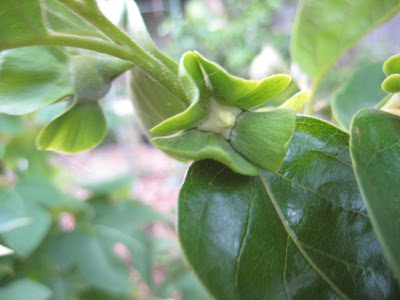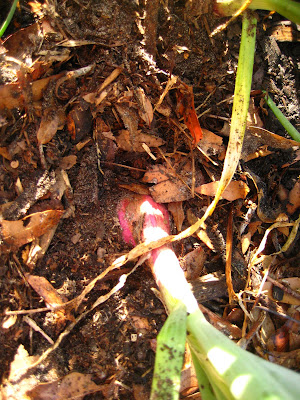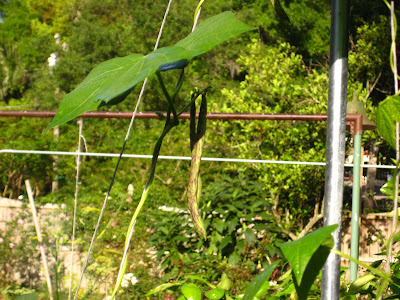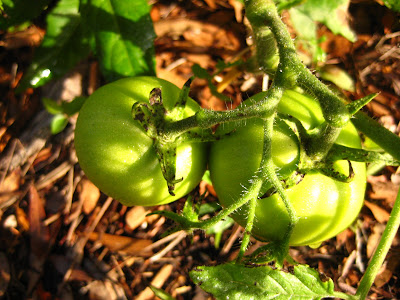"The greatest service which can be rendered any country is to add an useful plant to its culture especially a bread grain next in value to bread is oil."
(SERVICES OF JEFFERSON i 176 FORD ED vii 477 1800)
Sunday, April 27, 2008
Raising Cane


From my new-found gardening buddy, Felix, I got a five-foot length of freshly cut sugarcane lst Saturday. I dutifully stuck it in a pot of wet compost in the shade. I checked today for fungus and rot, and was amazed to find that the canes had already put out impressive roots. I promptly transferred them to the garden. I've never grown sugarcane, and I don't really have plans for it (what DOES one do with sugarcane, other than chew on it?), but I have space in the summer garden, and failing anything else, I can use the canes as green manure.
PlantFiles: Detailed information on Spotted Dead Nettle Lamium maculatum 'Anne Greenaway'


PlantFiles: Detailed information on Spotted Dead Nettle Lamium maculatum 'Anne Greenaway': "PlantFiles: Spotted Dead Nettle, Lamium maculatum 'Anne Greenaway'"
I got this at a GW plant swap recently. Very pretty, I think, for the shade garden. It's zone-nine hardy, or so my friend says.
Thursday, April 24, 2008
Lunar Light
I live in downtown DeLand, on a busy street with streetlights, it seems, every few feet (two on my small property zone alone). I've never understood why we have so many lights, generally speaking: Walking at night along a dark beach or a quiet road, I'm always struck by how little artificial light is really necessary to navigate and feel safe, especially when it's clear. My son is into stargazing, and a month or so ago we spent a new-moon night at Woodruff Preserve stargazing with the local high school astronomy teacher. It was as dark as one could imagine, but we had no navigating the alligator-infested, boggy area.
I have also noticed how street lamps, while illuminating their narrow radius, cast deep shadows at the periphery. It seems to me that outdoor lighting, which makes our eyes so less sensitive to ambient light at night, makes areas more dangerous: The perfect place to hide for a thug would be the wells of darkness beside houses and overgrown lots, taking advantage of our purblindness.
Give me full darkness any night.
Anyway, this entry's not technically on gardening, but it's Earth Day, and I often dwell here on the intertwined issues of sustainability, localism, and the need to appreciate the beauty of the world around us. Click through to read about a civil engineering idea that would change outdoor lighting for the better: "What if streetlights could respond to ambient moonlight, dimming and brightening each month as the moon cycles through its phases?...." But what was most striking was this (unsubstantiated but unsurprising) assertion:
I have also noticed how street lamps, while illuminating their narrow radius, cast deep shadows at the periphery. It seems to me that outdoor lighting, which makes our eyes so less sensitive to ambient light at night, makes areas more dangerous: The perfect place to hide for a thug would be the wells of darkness beside houses and overgrown lots, taking advantage of our purblindness.
Give me full darkness any night.
Anyway, this entry's not technically on gardening, but it's Earth Day, and I often dwell here on the intertwined issues of sustainability, localism, and the need to appreciate the beauty of the world around us. Click through to read about a civil engineering idea that would change outdoor lighting for the better: "What if streetlights could respond to ambient moonlight, dimming and brightening each month as the moon cycles through its phases?...." But what was most striking was this (unsubstantiated but unsurprising) assertion:
Lunar Light: Perhaps the most fascinating fact that the collective’s research revealed, however, is a little-known detail about the history of electricity: in the 1930s, with the spread of electrification and the consolidation of utilities, streetlights became a convenient way to off-load excess energy from the grid at night, when power demands dropped significantly. This intentionally inefficient system determined the norm for nighttime outdoor lighting levels, a standard that has not been revised since, even though the need for off-loading ended in the 1970s. What we now assume is a safety measure is in fact the forgotten remnant of an obsolete energy practice. Next Gen juror Fred Dust, head of IDEO’s Smart Space design practice, says the jury found this part of the proposal both shocking and compelling. “It’s such an archaic concept that it seems like science fiction,” he says.
Questioning current lighting standards and asking what level of illumination is actually necessary brings some surprising answers. Willis explains that the human eye, with its com-plementary systems of rods and cones, evolved to adapt to both full-sun days and moonless nights. “We can see an incredibly broad range of intensities,” he says. “The difference between sunlight and starlight is something like a hundred thousand orders of magnitude.” Bright moonlight is in"
Tuesday, April 22, 2008
Sandhill milkweed (Asclepias humistrata)
Asclepias humistrata, the Sandhill Milkweed. Growing in full sun, in sugar sand, here in Central Florida. I see it pretty regularly while fishing out at Lake Woodruff. Beautiful and tough as nails.
Persimmon Buds and Blossoms
Very subtle, the flower of a persimmon. They point down.


My tree grows in a container. It's about five feet tall, so probably will drop any fruit that manages to set. But I can hope, right?


My tree grows in a container. It's about five feet tall, so probably will drop any fruit that manages to set. But I can hope, right?
Blueberries in Florida

On impulse, a friend and I stopped by a u-pick blueberry farm outside Ocklawaha. Five bucks a pound for some delicious berries. It took, maybe, five minutes to pick three pounds. My wife made an absolutely amazing pie.
It's hard not to love Florida in April.
It's hard not to love Florida in April.
Sunday, April 20, 2008
The Green Issue - Climate Change - Environment - Energy Efficiency - Consumption - New York Times
The Green Issue - Climate Change - Environment - Energy Efficiency - Consumption - New York Times: "But there are sweeter reasons to plant that garden, to bother. At least in this one corner of your yard and life, you will have begun to heal the split between what you think and what you do, to commingle your identities as consumer and producer and citizen. Chances are, your garden will re-engage you with your neighbors, for you will have produce to give away and the need to borrow their tools. You will have reduced the power of the cheap-energy mind by personally overcoming its most debilitating weakness: its helplessness and the fact that it can’t do much of anything that doesn’t involve division or subtraction. The garden’s season-long transit from seed to ripe fruit — will you get a load of that zucchini?! — suggests that the operations of addition and multiplication still obtain, that the abundance of nature is not exhausted. The single greatest lesson the garden teaches is that our relationship to the planet need not be zero-sum, and that as long as the sun still shines and people still can plan and plant, think and do, we can, if we bother to try, find ways to provide for ourselves without diminishing the world."
Saturday, April 12, 2008
PlantFiles: Detailed information on Verdolaga-Francesa Talinum fruticosum
PlantFiles: Detailed information on Verdolaga-Francesa Talinum fruticosum:
"PlantFiles: Verdolaga-Francesa, Talinum fruticosum"
Such a great plant. Blooms all spring and summer... AND it tastes good.
Thursday, April 10, 2008
Something in the way of vegetables & fruit...
Chard ('Sea Foam' from Pinetree -- an excellent cultivar), carrots, sorrel, tomatoes & coriander. In a bed that I designed in circles.

Granex onions finally starting to bulb up. First time I've grown onions: Found a huge bunch of starts for sale in a hidden corner at Lowe's this winter. I've been thinning them and eating the young ones as scallions. Like most short day onions, these are sweet and therefore keep poorly, so I plan on leaving them in the ground as long as possible, pulling them as I need them. In a bed fmade from leaf mold.


My Rattlesnake Beans have kicked into high production. Last year, I didn't even plant these May, and they continued to produce well all summer, though the late summer beans were really only good as cannelinis (white beans). Very tasty, in any case -- a lot of rich, soya-like umami to them. Stay tender even when large, except in August and September. Grown up wires to an electrical conduit. I have a tomato growing up the conduit.

I was relieved to see this Nesbitt grape finally starting to leaf out. I moved it this past winter. My god, what a root ball! I had read that they are difficult to transplant, but it was harder than I'd expected. I root pruned it severely and cut the vine back dramatically, so I was a bit concerned that it hadn't yet broken dormancy. It's growing on my trellis, and these leaves are almost at the tip, which means that the vine survived well. It, too, has a bit of an aphid problem.

I'm vexed. I have no idea what tomato this is, but I planted the seeds back in January.


Granex onions finally starting to bulb up. First time I've grown onions: Found a huge bunch of starts for sale in a hidden corner at Lowe's this winter. I've been thinning them and eating the young ones as scallions. Like most short day onions, these are sweet and therefore keep poorly, so I plan on leaving them in the ground as long as possible, pulling them as I need them. In a bed fmade from leaf mold.


My Rattlesnake Beans have kicked into high production. Last year, I didn't even plant these May, and they continued to produce well all summer, though the late summer beans were really only good as cannelinis (white beans). Very tasty, in any case -- a lot of rich, soya-like umami to them. Stay tender even when large, except in August and September. Grown up wires to an electrical conduit. I have a tomato growing up the conduit.

I was relieved to see this Nesbitt grape finally starting to leaf out. I moved it this past winter. My god, what a root ball! I had read that they are difficult to transplant, but it was harder than I'd expected. I root pruned it severely and cut the vine back dramatically, so I was a bit concerned that it hadn't yet broken dormancy. It's growing on my trellis, and these leaves are almost at the tip, which means that the vine survived well. It, too, has a bit of an aphid problem.

I'm vexed. I have no idea what tomato this is, but I planted the seeds back in January.

Aphids on my fruit trees...
A bit of an aphid invasion of my pear and apple trees. The trees are tough, and the aphids don't last long around here. I gave them a good spray with a mix of neem and peppermint soap. The smell alone should chase them away. Ladybugs, where are you???
On my pear tree:

On my pear tree:

A quick garden update in pictures






anyone else grow alstoemeria? in pots, it's very perennial for me, coming back better every year. i put it in full shade, partial cover from the rain (under the eaves of my gazebo). it dies back completely every hot season, but bounces right back and blooms through winter, tho it really doesn't get going until the first batch of hot weather.

Monday, April 07, 2008
Common or Asiatic Dayflower
Common or Asiatic Dayflower: "Common or Asiatic Dayflower: Commelina communis"
I hate this weed more than any other in my garden.


